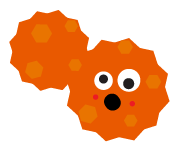
07.30.2018
MMRV Vaccine

The so-called MMRV, that is, measles, mumps, rubella, and varicella (chickenpox).
Varicella (chickenpox)
|
Measles
|
|
|
Varicella-zoster virus-induced acute infectious illness It is more common in youngsters under the age of 12. Almost everyone who contracts chickenpox becomes immune for life. However, the varicella virus can remain dormant in the body for many years and develop "herpes zoster," sometimes known as "Shingle" Patients typically develop a fever and an itchy rash, which emerges in waves over the course of around 5 days. Skin infections, scarlet fever, pneumonia, and encephalitis are more common in those with weakened immune systems. If a newborn baby contracts chickenpox, the disease can be serious, even fatal. Mostly by droplets or air, but also through direct or indirect contact with pathogen-carrying blister fluid from chickenpox or herpes zoster patients, which is disseminated by mucosal secretions. |
It is a highly contagious sickness caused by the measles virus. Infected individuals initially experience a fever, cough, runny nose, red eyes, and white patches in the mouth.
Spotted red rashes form on the skin and typically spread from the face to the entire body, lasting 4 to 7 days. It could take up to 3 weeks. Peeling or leaving brown patches The respiratory system, digestive tract, and brain will all be affected in severe cases. produce catastrophic repercussions or even death. Measles can be transmitted via airborne droplets or direct contact with patient nasal and throat secretions.Many places in the world have endemic measles. Every year, around 20 million individuals are infected with measles, the majority of whom live in poor nations of Africa and Asia. |
|
|
|
|
|
Mumps
|
Rubella (German Measles)
|
|
|
Caused by mumps virus occasionally affects the salivary glands Acute infectious illness that can also impact neurological tissue. There is no age limit for patients, but children over 1 year old are the most common Swollen and painful salivary glands, commonly localized in the cheeks, are symptoms. Complications such as deafness or infection of the brain, pancreas, testicles, or ovaries occur on occasion. The virus can be transferred through direct contact with a sick person's saliva or droplets.
Patients can be treated 2 days before and 5 days after the visible enlargement of the salivary glands. Mumps is more common in developing countries where immunization rates are lower. Outbreaks are still conceivable in vaccinated populations. Outbreaks can occur at any time of year, but they are more likely to occur in the north or south. In some places and nations, infection rates are highest in the winter and spring. |
due to the rubella virus Infected persons experience fever, cough, runny nose, red eyes, and white patches at first.
A blotchy rash will occur on the skin after 3 to 7 days, commonly extending from the face to the entire body.
The respiratory system, digestive tract, and brain will all be affected in severe cases. Rubella can be transmitted through contact with patients' nasopharyngeal secretions; thus, contact with droplets or direct contact with patients may result in infection. Rubella is highly contagious, and the sufferer can infect others for up to a week after developing the rash. |
|
Age |
Current Government Vaccination Program |
Medtimes MMRV Vaccination Service |
|
1 year old |
Varicella vaccine (1st dose)
|
MMRV Vaccine (1st dose) |
|
15 months old (the ealiest) |
- |
MMRV Vaccine (2nd dose) |
|
18 months old |
MMR vaccine (3rd dose) |
- |
|
6 years old (Primary 1)
|
MMR vaccine (3rd dose) |
- |
|
|
Total 3 doses |
Total 2 doses |
MMRV Vaccine
The Varicella vaccine injection provided in the government vaccine program and the 3-in-1 injection of MMR vaccine, a total of 3 injections throughout the injection process, and the newly launched MMRV vaccine, in addition to preventing chickenpox, also has measles, mumps and German measles, MMRV combines the varicella injection that needs to be injected separately and the 3-in-1 injection of measles, mumps and rubella. The combined vaccine not only reduces the number of injections by one, but also provides full protection to the infant before the 15th month. After two doses of vaccination, up to 99.8% of chickenpox immune responses can be elicited.
People who have been immunized against chickenpox can still get it (a condition known as "breakthrough infection"), but the symptoms are frequently milder or less characteristic, and the number of blisters is reduced. The rash is frequently maculopapular as opposed to vesicular. Those who have received vaccinations are shorter, however those who have not received vaccinations may have 300 or more irritating blisters at the time of commencement.
Guess you like













